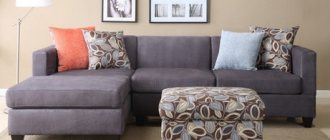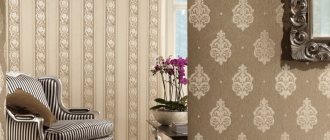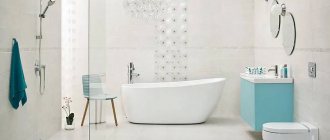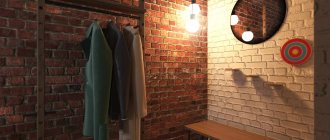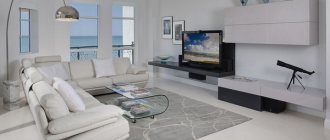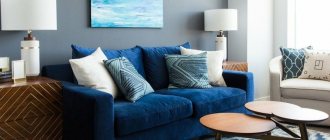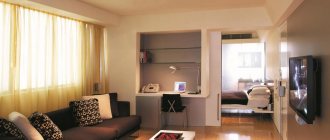The living room is the center of the house and sets the overall style for all other rooms in the house. They spend a lot of time there with their family, relax and recover after a hard day. In addition, during holidays or special dates, guests and friends gather in the living room. The right color scheme will lift your spirits and relieve stress.
Color selection criteria
The color palette can expand or narrow the space of a room. Hide flaws and highlight advantages. So, what influences the choice of colors for the living room:
- Room size
- Illumination level
- Wishes of the room owners
- Functionality requirement
For small rooms, the optimal solution would be a light and pastel color palette. They will make the room more spacious and comfortable. Complement the interior with a geometric or classic pattern on one of the walls to set the dynamics and enliven the design of the room.
Large rooms have no restrictions on the choice of color; any shades here will look advantageous. Playing with contrasts will look fresh and bright, soft transitions and gradients will add tenderness.
Before you start changing the color of the walls in the room
Without proper preparation of the walls for renovation, even the most beautiful colors of the rooms will look sloppy, and most importantly, they will not be durable. So before you decide how to paint your room, prepare the walls and the rest of the room for this complex process.
You need a lot of free space for painting. Additionally, paint dripping from a brush can damage furniture or other items in the room. Therefore, at the very beginning, make sure that all things in the room are removed from the room . If for some reason you can't do everything, take care of the rest. All objects, including the floor, should be covered with a special painting film to protect the room from possible paint splashes.
Preparing the wall for painting
A very important element is proper preparation of the wall for painting. Without this, even the most beautiful wall colors in the room will not be aesthetically pleasing or durable. To make sure the base is suitable for painting, touch the walls you want to paint. If you hear the characteristic "empty wall" sound, this means you need to apply new plaster to ensure that the colors chosen for the room stay on the walls for as long as possible.
If the walls of your room are covered with wallpaper, be sure to get rid of it before you start painting. Otherwise, applying paint to the wallpaper will cause it to get wet. As a result, the wallpaper will begin to peel off from the wall, bend and roll off. Even the most fashionable colors of the walls in the room will not save you from this situation .
How to paint a room whose walls were previously covered with opaque paint? It won't be easy to get rid of it, but it is possible. However, such a process will require a lot of effort and patience. In this case, it is better not to scrape off the paint with force, as this may damage the plaster. To make your work easier, you can use special preparations available on the market.
Criterion for cardinal directions
Before turning to the cardinal directions, objectively assess the degree of natural lighting in the room. If it's dull, choose light shades. If it is sufficient and even excessive, do not deny yourself anything.
- North side
This type of room is characterized by dim lighting and coldness. To balance these parameters and make the interior harmonious, use warm colors that will softly and unobtrusively fill the room with light and “warm” the overall perception. Yellow, green, beige and brown colors are suitable for this.
- South side
In this type of room there is a lot of heat and sun, so the opposite rules apply here. Use cool shades, so the room will be comfortable and cozy. Choose soft blue, turquoise and white shades.
- East side
For this type, a harmonious combination would be a warm and light color scheme. Pink, honey, peach tones are perfect.
- West side
This type of room “loves” cool shades. Gray, blue and mint shades look especially good.
Types of paints for room design
Alkyd
A special type of paint and varnish materials. Characterized by versatility of use. Alkyd paints come in matte, glossy, and semi-matte.
Among the main advantages of this coating are durability, quick drying and compatibility with any material.
Alkyd paint for wood, metal, and plastered surfaces
Emulsion
There are several varieties of this type of paint:
- Silicone. Universal, suitable for any surface.
- Latex. Versatile and damage resistant.
- Polyvinyl acetate. They are low cost, but not waterproof enough.
- Acrylic. Strong, resistant, durable.
- Water-based. Protects the surface from damage.
- Water-dispersed. They fit perfectly on brick, concrete, and wooden surfaces.
Emulsion paints
Textured
The main features of these paints that give them an advantage over others are the lack of ability to absorb odors, ease of use (they rarely get dirty), and environmental friendliness.
Textured paint for walls
Feng Shui Philosophy
Everyone has heard about this philosophy, but few really took it seriously. This is an old theory that helps create a favorable and comfortable environment by using different shades and objects. According to Feng Shui, it is generally accepted that each color carries a certain energy, which affects the general condition of a person.
The color palette is selected according to the theory of the feminine or masculine, and also takes into account the side of the world to which the room’s windows face.
Red
This color has long been feared for its excessive brightness and aggressiveness. However, now almost every interior contains this color in various shades and on various surfaces. You need to use it very carefully, because if you overdo it, you'll end up with a visual nightmare instead of a cozy living room. In order not to get tired and irritated in such an interior, you need to mute it with white, beige or brown colors.
We advise you not to use red in the decoration of walls or ceilings; it is better to focus on furniture, textiles or decorative items. To make your living room look more interesting, experiment with red patterns combined with other colors: red and white curtains, red and blue pillows.
amara.com
1/3
elledecor.com
2/3
elledecor.com
3/3
Beige palette
Shades in the beige palette are universal. They fit perfectly into any style, look warm and cozy. And if after a while the interior seems too boring, complement it with bright textiles, decorative elements, carpets, chairs, blankets, capes. The general perception will immediately change, and you will not have to make expensive repairs. Again.
Blue
Blue is one of the most sought after colors in the design world. It is quite difficult to use, but if you find a suitable pair for it, then believe me, your interior will radically change.
To break up the gloom of blue shades, use the aforementioned beige or white. Thanks to this combination of colors, you can create a maritime mood, which is sometimes so lacking in city apartments. However, this combination can often look too cold.
Add to these colors a bright red carpet and purple accents on textiles, then the blue and white design of the room will be transformed and you will get a full-fledged vintage interior. Just don’t forget in this case to add unusual decorative items: carved candlesticks, fresh flowers, marble vases and unusual lamps.
elledecor.com
1/3
elledecor.com
2/3
elledecor.com
3/3
Blue palette
Such shades are associated with freshness, lightness and have a relaxing effect. For those who are constantly under stress, this solution will be optimal.
Burgundy
Not every owner will like this color, since burgundy is a very expressive shade by nature. However, if you correctly fit it into the interior of the living room, you will get an expressive and expensive-looking room.
This color is rarely used in wall decoration. But if the soul demands, we will not resist it. In this case, use a warm shade and keep the surface of the walls glossy - this way you will minimize the excessive saturation of this color.
As a rule, burgundy is used in furniture upholstery, textiles and decor. It becomes a bright accent in any room.
shirokoi.org
1/3
annaburkeinteriors.com
2/3
hgtv.com
3/3
White palette
White colors are neutral and by adding different tones of the color spectrum they achieve different therapeutic effects. This color will add light and lightness and will become a blank canvas for the artist - the owner of the living room.
Violet
This color has a large number of shades of different temperatures and brightness, so it is very interesting to work with it in the interior of the living room. As you understand, there are a lot of options for combinations with purple.
The only caveat: don't use dark purple alone, otherwise you risk turning your living room into a Count Dracula crypt. To create an unusual interior, abandon the classic white or beige shades, give preference to contrasting tones that will bring brightness and fun to the living room. To do this, use green, orange, blue, red or brown. The listed colors can be either bright or pastel. The main thing is to find a balance and fit each shade appropriately. In the photographs you can see very unusual and striking examples.
amara.com
1/3
elledecor.com
2/3
elledecor.com
3/3
Green palette
The most natural color that reflects inner harmony. Green is used to create eco-interiors, which are very popular now.
How to paint a room in several colors? Color combinations that always work
The walls of the room do not have to be painted the same color. However, the art of combining them is not the simplest. To be able to experiment with shades without worrying about the effects, you should learn the basic principles of color combinations. Only by knowing these dependencies can you choose bold combinations and adapt the various shades of the palette to your needs.
The color wheel is a very useful element when choosing colors. It has 12 flowers. These are three primary colors, three derivative colors and shades resulting from a combination of primary and secondary colors, that is, the so-called third-order colors. How to paint a room so that it looks aesthetically pleasing and has the desired character? It is enough to select shades using the colors on the circle.
Monochrome room wall colors
There are several color combination options. One of them is a combination of monochrome colors , that is, a combination of several tones of the same color. For example, using brown or green from lightest to medium to darkest. Such combinations are perfect, for example, in the bedroom.
Opposite room colors
Another option is to combine opposite colors with each other. These are the so-called complementary colors, that is, those that are always opposite to each other on the color wheel. This method of combining colors is perfect for large rooms, such as a living room. It is also a great solution for events and public spaces. Bold color combinations through contrast create a desire to take action and awaken layers of positive energy.
Yellow palette
The color of the sun and good mood. Our subconscious perceives it as a messenger of wonderful news. Under its influence, the depressive state goes away, energy and vitality appear.
Brown
Brown is another color that will not go out of style for a long time due to its versatility. It can fit into any interior: be it cozy Scandinavian or luxurious classic style. The classic combination - brown and white, coffee with milk - is used very often by designers in living room interiors, as it creates both a cozy and luxurious atmosphere. White color in this combination creates a background for brown shades, highlighting them favorably.
To make the brown and white palette sparkle with colors, add fresh flowers and unusual decorative elements to the interior, as shown in the photo below. Just a couple of touches - and the living room takes on a touch of nature.
amara.com
1/2
elledecor.com
2/2
Olive palette
It is made by mixing green and yellow. He took the best from everyone. The interiors in its design appear calm and positive. In addition, they look noble, solid and expensive. A unique shade that all designers love dearly.
Painting walls and ceilings step by step, or how to paint a room
For painting it is best to use a large paint roller. Unlike a brush, it does not require special skills and guarantees a good effect. The paint will be evenly distributed, and after several applications, streaks will not be visible. However, be sure to spread the paint evenly over it once the roller is wet in the tray (using the "grater" on the tray) and remove any excess.
Peach palette
It symbolizes the summer mood of carefreeness, the threshold of positive events. Suitable for classic, modern, art deco or fusion styles.
Winter Garden
Another way to create an atmosphere close to nature is to fill the living room with natural shades: brown, sand and grass green. They support the “forest” theme, calm, set the mood for relaxation and provide an opportunity to escape from the bustle of the metropolis.
When creating such an interior, it is important to maintain a balance: coffee and beige tones should serve as a background for green, and not vice versa.
Turquoise palette
Creates space and an atmosphere of a fresh summer breeze. Positively affects the psyche and general state of mind. This palette consists of many additional tones. From dark deep to light and weightless.
Vivid contrasts
Combinations of pure shades (for example, red and blue) are rarely used in interior design - they are more often found in children's rooms, but even here, trends in recent years have tended towards more muted and complex palettes.
A combination of coral and turquoise is perfect for decorating a bright living room - they are on opposite sides of the color wheel, due to which they look harmonious together.
Popular colors
Despite the individuality of each living room, there are trends that most people follow. There are many styles in which the living room interior can be decorated.
But everything can be combined into two large groups:
- Classic design;
- Modern design.
There is also a mixed look, but here one or another design option still predominates.
Modern style
In modern living room designs, minimalism, airiness and functionality are more welcome. Therefore, deep shades are used only pointwise. Wallpaper with a pattern is very rare here. Most often, the walls are plain; textured plaster can be used. Heavy curtains are replaced with blinds or roller blinds.
There is a lot of white and its shades. The main mood is set by accessories: paintings, furniture, rugs. Metallic colors are often present. Lots of gloss and light.
The modern style of the living room does not have any clear rules. Almost everything is possible here. The main thing is to observe moderation.


